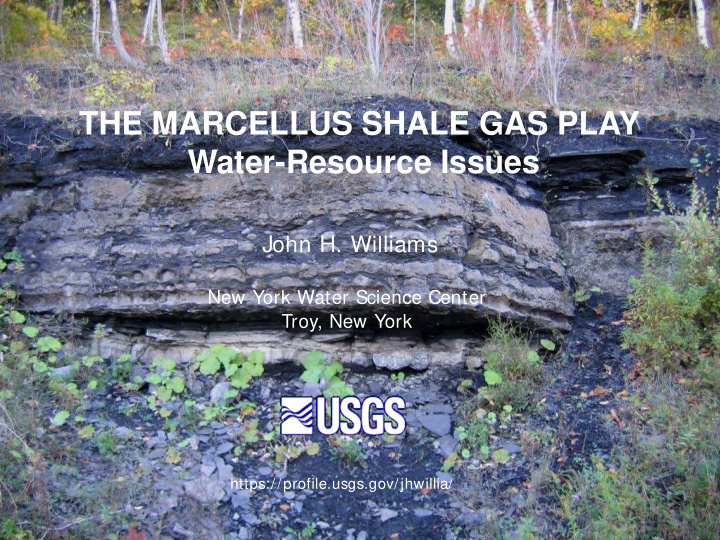



THE MARCELLUS SHALE GAS PLAY Water-Resource Issues John H. Williams New York Water Science Center Troy, New York https://profile.usgs.gov/jhwillia/
Water Resource Issues • Drill cuttings • Frac flowback • Faults and fractures • Methane migration /
Horizontal wells target basal Marcellus Shale Teff (2011)
High TOC and elevated radioactivity in basal Marcellus Shale Tompkins County, NY Levanthal and others (1981)
Uranium & Thorium to Radium & Radon Radioactive Decay Series Radioisotope and half life
High TOC and abundant pyrite in basal Marcellus Shale Gamma Log Drill Core Sample Analysis Lash and Engelder (2009)
Drill Cuttings • Elevated uranium and abundant pyrite in high-TOC black shale • Multi-horizontal well site will generate more than 500 times the volume of shale cuttings than single-vertical well site Core of target interval Drill cuttings
Drilling Fluids and Cuttings Closed-loop system Lined pit Offsite disposal in landfill Mixed with sawdust
Flowback Contains elevated TDS, chlorides, barium, and radioisotopes whose concentrations increase during the flowback period approaching formation brine Blauch (2010 ) Papso and others (2010 )
TDS and Radioactivity of Flowback Water Kirby (2011) Ra-226 increases relative to Ra-228 in the later higher TDS flowback consistent with a U-rich source for the water such as the Marcellus shale (Engle and others, 2011)
Municipal wastewater treatment plants not designed to handle flowback chemistry Limited number of disposal wells in Ohio Reuse flowback, onsite treatment for solids / blend with 70 % freshwater
Microseismic Mapped Frac Tops and Bottoms Marcellus Shale Fisher (2010)
Faults and Fractures Shallow faults Upper Devonian bedrock containing freshwater aquifers above sandstone gas reservoirs. Deep-seated Burkett Shale fracture zone Tully Limestone Marcellus Shale Onondaga Limestone Salt Salt pillow Seismic data courtesy Seismic Line from North-Central Pennsylvania of Shell Appalachia
Avoid Hydraulic Fracturing across Structures Teff (2011)
Methane in Water Wells Marcellus/Utica Gas-Play Area Sampling sites Osborn and others (2011)
Marcellus Gas-Well Construction 2,500 – 4,000 feet
Top-set rig for drilling vertical surface- and intermediate- cased interval Directional rig for drilling horizontal leg
~15 ft Wellheads of first two of six horizontal wells
Good Zonal Isolation CONDUCTOR PIPE FRESH WATER AQUIFER ZONE SURFACE CASING PRODUCTION CASING SHALLOW PRODUCING ZONE INTERMEDIATE PRODUCING ZONE TARGET PRODUCING ZONE
Poor Zonal Isolation CONDUCTOR PIPE PRESSURE FRESH WATER AQUIFER ZONE BUILDS UP SURFACE CASING PRODUCTION CASING FORMATION CASING CEMENT SHALLOW PRODUCING ZONE INTERMEDIATE PRODUCING ZONE TARGET PRODUCING ZONE
Geophysical Logs and Base of Freshwater Aquifer Freshwater Transition Saltwater Log data courtesy of Shell Appalachia
Shale Gas Development Best practices based on state-of-the-art technology and science • Geophysical logging to delineate base of freshwater aquifers • Surface casing/cement deep enough to protect freshwater aquifers • Intermediate and production casing/cement/packers to prevent upward migration of gas • Cement-bond logging and pressure testing to ensure good seals • Drilling and frac fluid storage in tanks and offsite burial of drill cuttings • Avoid hydraulic fracturing near structures • Microseismic monitoring of hydraulic fracs • Reuse of frac fluid reduces freshwater resource impacts and disposal issue • Water-well sampling before and after drilling/hydraulic fracturing operation
Recommend
More recommend